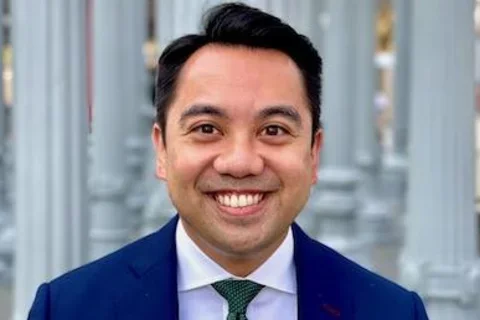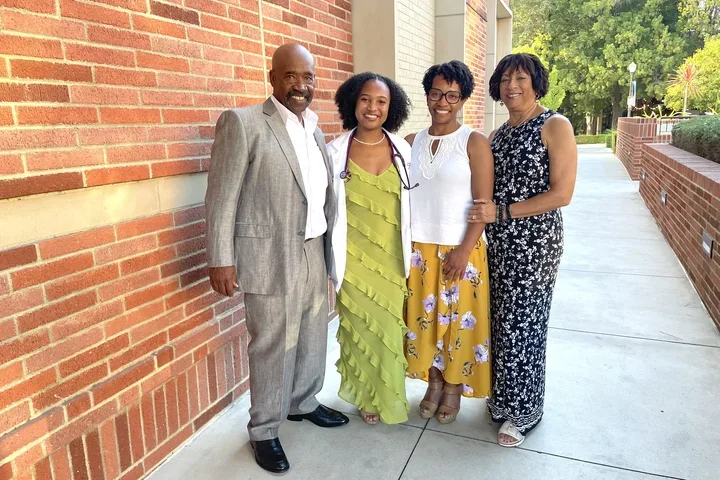A doctor’s work on homelessness and societal mental health

'Sometimes people view mental health treatment as a "magic bullet" for homelessness – but we can’t medicalize a social problem.'
By Jocelyn Apodaca Schlossberg
Dr. Enrico Castillo, associate director of residency education at UCLA Semel Neuropsychiatric Institute and public psychiatrist
Enrico Castillo, MD, MSHPM, got into medicine to help people, to understand patients' perspectives and stories and to change people’s ways of thinking about mental illness.
A second-generation Filipino American raised in rural southwestern Virginia, Dr. Castillo, associate director of residency education at UCLA Semel Neuropsychiatric Institute and a public psychiatrist, was exposed to the field from a young age because his father was an emergency medicine physician.
“The thing that I took away from my father’s career is that medicine is a great opportunity to help people,” Dr. Castillo says.
But when he entered the field of psychiatry, he also realized that “my father had, as do many people in the Filipino American community, a very high stigma about mental illness.” In a 2020 systematic review, researchers found that among Filipinos, cultural beliefs paired with financial constraints, inaccessibility of services, lack of health insurance, language barriers, and experiences of discrimination contribute to disparities and low use of mental health services.
Dr. Castillo says reflecting on the importance of his career helped prepare him for conversations with his father “about my chosen career and, I think, reckoning with the stigma that he had,” he says.
Those discussions helped his father understand the importance of mental health, and what taking on this career meant to Dr. Castillo, now also an assistant professor and health services and health policy researcher in the UCLA Center for Social Medicine and Humanities.
Besides changing minds at an individual level, he is also focusing on addressing systemic issues caused by racism and structural inequities.
“I experienced a lot of racism within my school system, racism that wasn't responded to,” he says. “Seeing that at an early age, I always had this focus on systems and how they can affect people, starting with myself.”
Myths about people experiencing homelessness
Dr. Castillo wants public systems to better serve people who are under-resourced and have serious mental illness. While in his public psychiatry fellowship at Columbia University, he specialized in field-based services for homeless populations. He is now a researcher focused on homeless services and a clinician-educator who teaches about the structural causes of homelessness.
There are two prevalent myths about homelessness that he says must be debunked: 1. Most people who are unsheltered have mental illness; 2. We don’t know what to do about homelessness.
“Multiple studies have shown that the majority of people experiencing homelessness have neither mental illness nor substance use disorders,” Dr. Castillo says.
“Sometimes people view mental health treatment as a ‘magic bullet’ for homelessness – but we can’t medicalize a social problem.”
What he finds distracting about that belief is that it can take away resources and attention from true solutions, which are affordable housing and permanent supportive housing.
“Homelessness is such a complex problem that many think we don’t know what to do about it. That’s completely false,” he says. He points to two examples which show that economic and social responses have been successful in getting people off the streets.
Finland is the only European country where homelessness is decreasing—from 20,000 in the 1980s to just over 4,000 people in 2021. In 2008, a policy called Housing First established a goal to create 2,500 long-term homes for people experiencing homelessness. Since its launch, homelessness has fallen by 35% and unsheltered homelessness has been nearly eliminated.
The other example is New York City, where there is a larger homeless population than the homeless population in Los Angeles County, says Dr. Castillo. But residents of New York City have a “right to shelter,” which requires the city to provide emergency shelter to all who qualify.
“For example, 4% of (New York’s) population experiencing homelessness is unsheltered, compared to 75% in L.A.,” he says. “New York is not perfect, but they do provide shelter and people have a right to shelter, but we don’t have a right to shelter here.”
He says it’s important for medical professionals to engage with civic, state and federal leaders – to vote, write op-eds and letters to the editor and change institutional policies and laws.
He also encourages partnerships with community-based organizations working to address health and social inequities. “People can volunteer, donate and lend their professional voice to these organizations and movements.”
And when physicians and health care professionals do community outreach, it’s important to center the voices and needs of patients in under-resourced communities first, he says.
Changing how we teach medicine
One way to ensure that structural action takes place in medicine is by incorporating change into medical education.
“I'm really excited about the ways that medical education is changing, but it needs to change more because a lot of the things that we teach medical students, residents and fellows, were codified in the 90s,” Dr. Castillo says. “It's 2022 in L.A. and so the things that we need to teach medical students and other trainees should be about L.A. in 2022.”
To address inequities in medical education, Dr. Castillo says, educators must teach the local context regarding local structures and the social forces that shape how decisions are made. One suggestion he has, articulated in a May 2021 article in the Journal of General Internal Medicine, is that all research projects should be judged based on their potential impact on inequities and local communities.
He cautions against the ways biomedical interventions can put “blinders” on health care professionals.
“Our patients have multifaceted, complex needs and not all of it can be solved biomedically,” he says. “I think if we can reconnect to our desire to help people, whether that’s a social intervention or community partnership, we can begin to develop and use other tools in our toolbox.”
Dr. Castillo shared a list of Los Angeles-based organizations physicians and health care professionals can explore to help address health inequities:
Learn more about health equity, diversity and inclusion efforts at UCLA Health.
- U ACT
- Frontline Wellness Network
- BLM-LA
- JusticeLA
- La Defensa
- Healthy African American Families
- KTown4All
- Services Not Sweeps
- The People’s Budget Los Angeles
- Los Angeles Community Action Network
- The People Concern
- Project 180
- Inner City Law Center
- Esperanza Immigrant Rights Project
- Asian Americans Advancing Justice - Los Angeles
- Chinatown Community for Equitable Development



